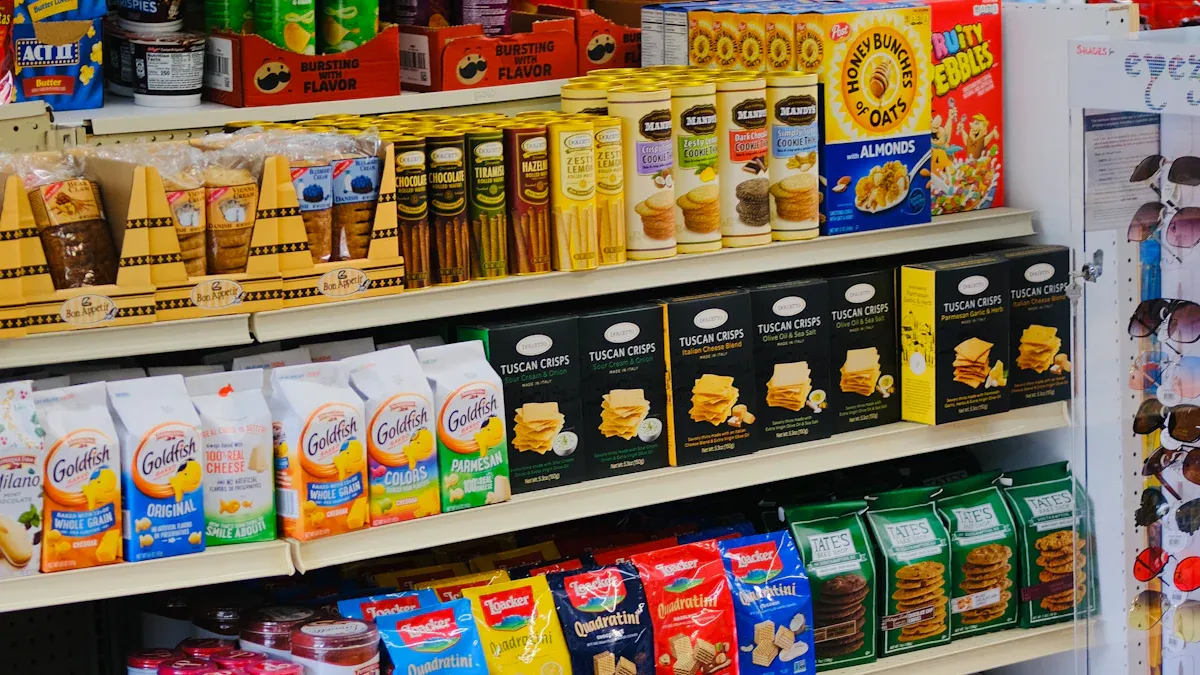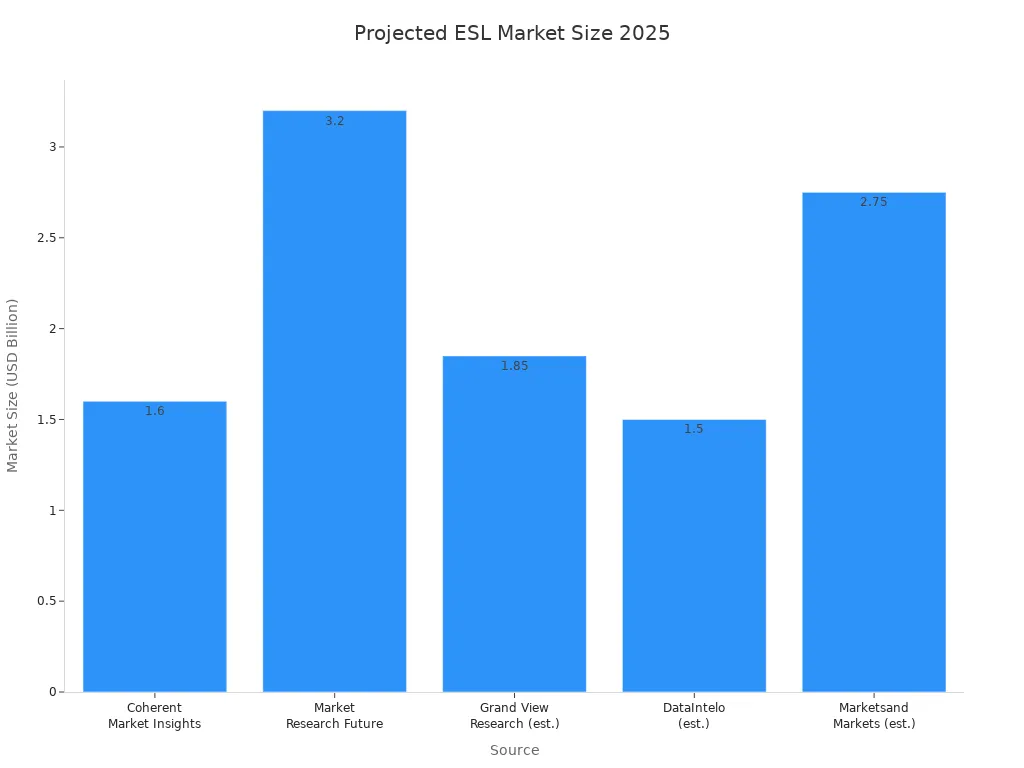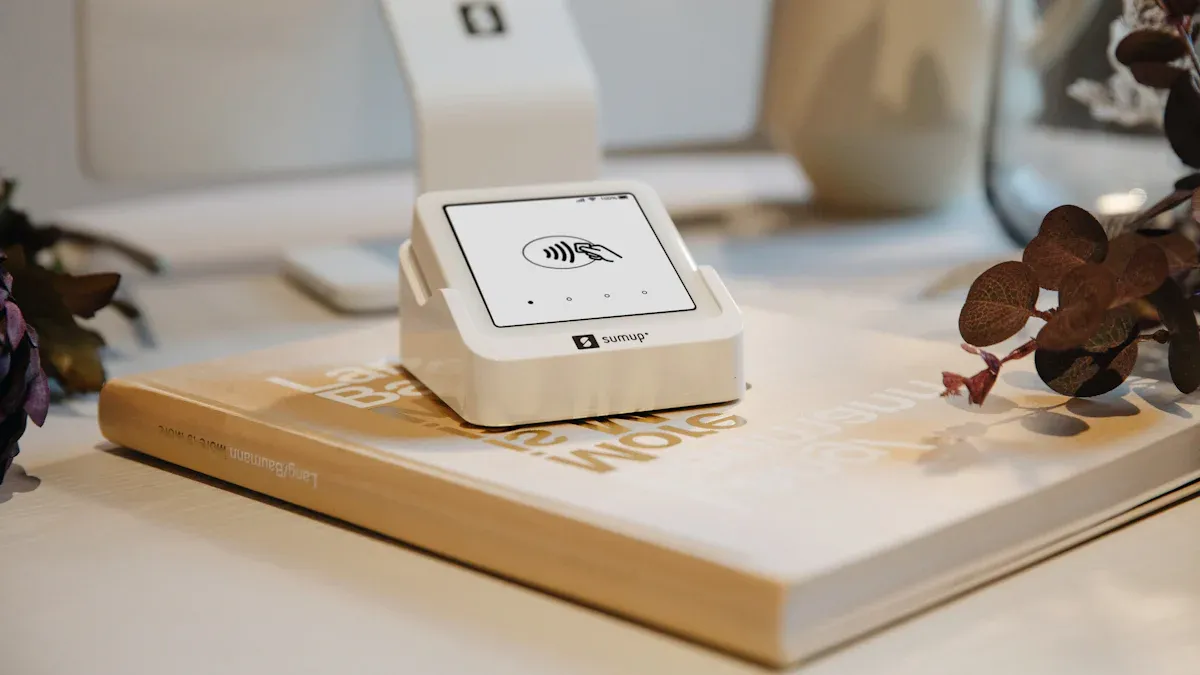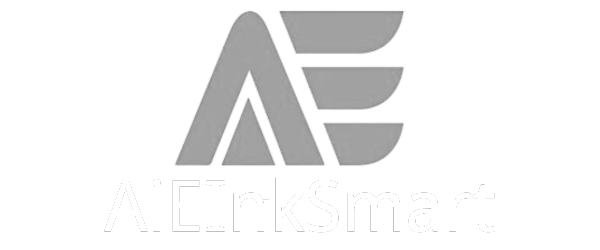
Electronic shelf labels (ESL) transform how stores manage pricing by displaying accurate product information on digital screens. In 2025, ESL systems use wireless networks and centralized management tools to ensure every ESL Price Tag reflects current data. Retailers rely on the ESL Gateway AP to transmit updates instantly, streamlining operations and reducing manual errors. The market for electronic shelf labels continues to expand, with projections in 2025 ranging from USD 1.6 billion to USD 3.2 billion, as shown below:
| Source | Projected Market Size for ESL in 2025 (USD Billion) |
|---|---|
| Coherent Market Insights | 1.60 |
| Market Research Future | 3.20 |
| Grand View Research | ~1.85 (2024 figure, 2025 implied higher) |
| DataIntelo | ~1.5 (2023 figure, 2025 implied higher) |
| MarketsandMarkets | ~2.5-3.0 |

Esl Retail leverages these advancements to offer efficient, real-time solutions for modern stores. ESL technology, with its robust connectivity and instant updates, empowers retailers to meet market demands with precision.
Main Components of Electronic Shelf Labels

Digital Display Technology (e-paper, LCD, e-ink)
Electronic shelf labels rely on advanced digital display technologies to present product information, prices, and promotions. In 2025, e-paper displays dominate the market due to their energy efficiency and excellent readability. Retailers prefer e-paper for its paper-like appearance and low power consumption, which only occurs during updates. LCDs and e-ink displays also appear in ESL systems, offering higher refresh rates and color support. However, LCDs consume more power and struggle with glare in sunlight. The table below compares the main display types used in ESLs:
| Display Type | Advantages | Disadvantages |
|---|---|---|
| E-ink (E-paper) | Low power use, sunlight readable, long battery life | Monochrome, slow refresh, limited visuals |
| LCD | Fast refresh, color support, good in dark settings | High power use, glare in sunlight, shorter life |
| E-paper (general) | Paper-like readability, low power | Slower refresh than LCD |
Innovations such as four-color e-paper and large-format printed e-paper ESLs have improved cost efficiency and robustness, especially in grocery retail environments.
Wireless Communication Systems (RF, Bluetooth, NFC)
Wireless communication forms the backbone of ESL operation. In 2025, ESLs use protocols like Bluetooth Low Energy (BLE), Wi-Fi, Zigbee, and HiLPC to transmit data between tags and central management systems. BLE and HiLPC stand out for their ultra-low power consumption and stable connectivity, supporting rapid updates for thousands of ESL devices. Wi-Fi and Zigbee offer reliable long-range communication, while NFC enables short-range data exchange and personalized promotions. These protocols ensure that ESLs receive real-time updates and maintain efficient store operations.
Tip: Choosing the right wireless protocol impacts ESL battery life and update speed. BLE and HiLPC are ideal for stores seeking energy efficiency and fast synchronization.
Power Supply Solutions (batteries, energy efficiency)
Power supply remains a critical factor in ESL design. Most ESLs in 2025 use batteries, with lifespans ranging from five to ten years depending on usage and update frequency. E-paper displays and low-energy wireless protocols help extend battery life. Some ESLs feature user-replaceable battery packs, reducing downtime and maintenance costs. Active energy harvesting technology is emerging, allowing ESLs to operate without batteries by converting electromagnetic energy from transmitters into usable power. This innovation supports battery-free, always-on ESL operation and reduces environmental impact.
| Feature | Description |
|---|---|
| Typical Battery Life | 5–10 years, depending on usage and display type |
| Energy Efficiency | Optimized power management, BLE protocols, minimal refresh cycles |
| Future Improvements | Solar and kinetic energy harvesting, smart battery monitoring |
Retailers benefit from these advancements by lowering maintenance costs and improving sustainability.
Centralized Management Software
Centralized management software serves as the command center for electronic shelf labels in 2025. This software connects every ESL in the store to a single platform, allowing retailers to manage pricing, promotions, and product information with precision. The system integrates seamlessly with the store’s inventory and price management system, ensuring that every price change or product update reflects instantly on the shelf.
Standard features in modern centralized management software include:
- Dynamic pricing that updates in real time based on market trends or inventory levels.
- Integration with Point of Sale (POS) systems to maintain price consistency across all channels.
- Inventory tracking that adjusts promotions or alerts staff when stock runs low.
- Customizable display options, such as fonts, colors, QR codes, and promotional badges.
- Built-in analytics to monitor price changes and measure promotion effectiveness.
- Remote management for controlling multiple store locations from a single dashboard.
- Advanced security protocols to protect sensitive data and customer information.
Note: Centralized management software uses secure wireless technologies like Wi-Fi and Bluetooth to transmit updates instantly to thousands of ESLs, ensuring accuracy and reliability.
Retailers benefit from several key capabilities:
- Uniform updates across all products, reducing manual errors.
- Real-time synchronization with POS and inventory systems for seamless operations.
- Cloud-based or on-premise infrastructure options, offering flexibility and scalability.
- Robust security measures, including end-to-end encryption and multi-factor authentication.
- Remote access and control, enabling efficient management of multiple stores.
- Monitoring and logging features that help maintain system reliability and data integrity.
Centralized management software empowers retailers to implement dynamic pricing strategies, respond quickly to market changes, and maintain consistent pricing across physical and online stores. This technology reduces labor costs, improves operational efficiency, and builds customer trust through accurate, up-to-date information.
How Electronic Shelf Labels Operate
Data Input and Price Changes
Retailers manage pricing and product information for electronic shelf label systems through centralized databases. The process begins when price data enters the main computer system at a retailer’s headquarters. This information flows to individual stores, where it is stored locally and distributed to both point-of-sale systems and electronic shelf labels. The esl network enables dynamic pricing, allowing real-time adjustments based on competitor activity, stock levels, and sales velocity. Retailers use integrated software to automate price updates, eliminating manual shelf intervention.
Electronic shelf label systems support frequent and agile price modifications. For example, Walmart’s adoption of esl technology allows associates to update prices for over 120,000 products in minutes, compared to the days required for manual changes. Some stores can adjust prices on individual items as often as six times per hour. This rapid updating capability supports markdowns, promotions, and inventory management strategies. AI and advanced analytics optimize stock levels and pricing, responding instantly to demand patterns. The centralized and automated process reduces labor, minimizes errors, and ensures price accuracy across all channels.
Note: Automated price changes with esl systems help retailers maintain compliance, reduce waste, and respond quickly to market trends.
Synchronization with Store Systems
Electronic shelf label networks synchronize with store inventory and pricing systems to maintain consistency and accuracy. Integration with POS and inventory management platforms enables instant updates of prices and product availability. The esl system connects shelves to the pricing engine, ensuring that every label reflects the latest information. Retailers synchronize product details, stock status, and marketing content, reducing out-of-stock situations and excess inventory.
- ESLs synchronize pricing and inventory data with online stores, mobile apps, and multiple store locations.
- Automated price updates eliminate manual tag replacement, reducing human errors and pricing discrepancies.
- Dashboards collect accurate data on product availability, facings, and pricing, supporting operational decisions.
- Employees focus on customer service and inventory management, rather than manual price changes.
- Quick and dynamic price adjustments allow stores to respond promptly to market changes and promotions.
Integration with wireless communication technologies such as Bluetooth Low Energy, Radio Frequency, and Near Field Communication enables real-time updates directly on shelf labels. This synchronization ensures pricing accuracy close to 100%, eliminating discrepancies between shelf and register prices. Retailers benefit from reduced labor costs, improved operational efficiency, and enhanced customer experience.
| Challenge Category | Specific Issues and Considerations |
|---|---|
| Compatibility | Not all POS systems support esl connectivity; software upgrades or middleware may be required. |
| Connectivity & Synchronization | Stable Wi-Fi or Bluetooth coverage is essential; backup systems and diagnostics prevent failures. |
| Manual Update Errors | Manual price updates are tedious and error-prone, risking pricing discrepancies. |
| Staff Training & Adoption | Employees may resist new systems; hands-on training and user-friendly interfaces encourage adoption. |
| Maintenance & Troubleshooting | Battery replacements and software updates are needed; troubleshooting guides support issue resolution. |
| Initial Investment & Scalability | Upfront hardware and integration costs; leasing and volume discounts can mitigate expenses. Future-proofing is key. |
Tip: Retailers should invest in robust connectivity and staff training to maximize the benefits of electronic shelf label synchronization.
Wireless Data Transmission
Electronic shelf label systems rely on advanced wireless data transmission methods to deliver updates from centralized management platforms to shelf labels. Modern esl networks use radio frequency, infrared, Bluetooth Low Energy, Wi-Fi, Near Field Communication, and visible light communication. Radio frequency-based solutions dominate the market due to their reliability and range. Two-way communication allows labels to confirm receipt of updates and report status, conserving battery life and ensuring system integrity.
- Wireless communication methods used in esl systems include:
- Radio Frequency (RF)
- Infrared (IR)
- Bluetooth Low Energy (BLE)
- Wi-Fi
- Near Field Communication (NFC)
- Visible Light Communication
These technologies enable real-time updates and vary in range, power consumption, and application. Security remains a top priority. The Bluetooth Special Interest Group introduced a new wireless standard for electronic shelf label networks, leveraging Bluetooth 5.4 features for ultra-low power consumption and high security. Hardware-based security measures, such as cryptographic ciphers and secure boot protocols, protect against tampering and unauthorized access. Retailers benefit from secure, scalable, and interoperable wireless communication, safeguarding business operations and brand integrity.
Security Alert: Retailers should ensure their esl networks use encrypted wireless protocols and hardware-based security features to protect sensitive data.
Real-Time Display Updates
Retailers in 2025 rely on real-time display updates to maintain accurate pricing and product information on every shelf. The electronic shelf label system enables stores to react instantly to market changes, promotions, and inventory adjustments. When a price or product detail changes, the process begins with data entry into the central management software. This software synchronizes and prepares the information for distribution across the network.
The update process follows a streamlined sequence:
- Data enters the central management software.
- The system synchronizes and organizes the information for each product.
- Wireless communication gateways transmit the data to all esl devices in the store.
- Each electronic shelf label refreshes its display immediately upon receiving the new data.
This workflow eliminates manual relabeling and saves significant time for store staff. Pricer’s electronic shelf labels, for example, allow retailers to update prices and promotions instantly across all locations. This capability ensures that customers always see the most current and accurate information, supporting immediate responses to market trends.
Several factors influence the speed and accuracy of these real-time updates:
- Wireless communication technology must integrate seamlessly with the store’s existing infrastructure.
- Display clarity determines how quickly customers and staff can read updated information.
- Battery life affects the reliability of continuous updates.
- Durability ensures consistent performance in various retail environments.
- Integration with POS systems and network infrastructure guarantees accurate pricing and inventory data.
- Proper assessment of current technology and collaboration with vendors help address compatibility and scalability challenges.
Direct connections between esl systems and store databases play a crucial role in improving update speed and accuracy. This linkage reduces human error and enables instantaneous price changes throughout the store. As a result, electronic shelf label solutions provide a reliable foundation for real-time pricing, inventory management, and customer trust.
Tip: Retailers should regularly evaluate their wireless infrastructure and esl integration to maintain optimal real-time update performance.
Installation and Setup of Electronic Shelf Price Tags
Physical Placement and Mounting
Retailers begin the installation of electronic shelf price tags by preparing the store environment and gathering essential tools. Gloves, cutter knives, box tape, remover tools, and marker pens help ensure a smooth process. Staff unbox and inspect each electronic shelf price tag, checking for damage or missing units. They then secure mounting rails to shelf edges using appropriate fasteners. These rails provide a stable foundation for the electronic shelf price tags.
Labels clip onto the rails, following grooves designed for a secure fit. In high-traffic or vibration-prone areas, clips and clamps hold the electronic shelf price tags firmly in place. Specialized brackets, such as peg hook brackets for pegboards or pole-to-ice mounts for cold storage, support unique retail environments. Angle adjusters on rails improve label visibility for customers. Some stores dismantle old racks and install new fixtures to accommodate the latest electronic shelf price tags.
Tip: Proper placement and secure mounting reduce maintenance needs and ensure consistent performance of electronic shelf price tags.
Network Configuration
After physical installation, staff configure the network to connect all electronic shelf price tags. The process starts with initializing each tag, often using NFC or a button press to establish a connection with the store’s gateway. Staff verify that each electronic shelf price tag communicates with the central management system. Network configuration includes assigning each tag to its correct location and SKU, ensuring accurate data display.
A stable wireless environment is critical. Staff check signal strength and coverage throughout the store. They may adjust access points or gateways to eliminate dead zones. Proper network configuration ensures that electronic shelf price tags receive updates reliably and operate efficiently.
Initial Synchronization
Initial synchronization links electronic shelf price tags to product data and store systems. Staff carry prepared tags to their designated sections and attach them to rails or mounting accessories. Each electronic shelf price tag receives its SKU assignment and displays the correct product information. Staff verify that every tag connects to the gateway and displays accurate pricing.
The process includes compliance checks to ensure all electronic shelf price tags meet store standards. Ongoing support, such as battery replacement and maintenance, forms part of the installation lifecycle. Proper initial synchronization guarantees that electronic shelf price tags function as intended from day one.
Note: Regular maintenance and periodic checks help sustain the performance and accuracy of electronic shelf price tags.
Key Benefits and Applications of Electronic Shelf Labels in 2025

Real-Time Pricing and Promotions
Retailers in 2025 rely on electronic shelf labels to deliver instant price changes and targeted promotions. These systems support dynamic pricing, allowing stores to adjust prices in response to market trends, competitor activity, or inventory levels. The table below highlights the main benefits:
| Key Benefit | Description |
|---|---|
| Real-time Dynamic Pricing | Enables instant price changes via software, improving customer loyalty and store efficiency. |
| More Product Information | Displays detailed product data beyond price, including stock levels, origin, and reviews. |
| Environmental Benefits | Reduces paper and plastic waste by eliminating frequent label printing and replacements. |
| Time and Accuracy Savings | Batch updates reduce errors and free employees for customer service. |
| Showrooming Prevention | Allows stores to match online prices dynamically, reducing lost sales to online competitors. |
| Quick Payback on Investment | Installation is cost-effective with increased sales and profit margins reported. |
Retailers use dynamic pricing to maximize profit margins and respond quickly to demand. Customers benefit from accurate, up-to-date information and tailored promotions, which enhances satisfaction and trust.
Streamlined Inventory Management
Electronic shelf labels transform inventory management by automating routine tasks and providing real-time data. Stores replace manual price tag changes with instant digital updates, saving time and reducing errors. Key advantages include:
- Automated price adjustments ensure consistency between shelf and register prices.
- Staff spend less time on repetitive tasks and more on customer service.
- Analytics from ESLs help managers understand product performance and customer interactions.
- Features like QR codes and NFC improve inventory tracking and guide restocking.
- Real-time inventory updates reduce stockouts and pricing errors.
Retailers report faster order picking and restocking, as ESLs can light up product locations. These improvements increase productivity and support efficient stock replenishment.
Omni-Channel Integration
Omni-channel retailing depends on seamless integration between physical and online stores. Electronic shelf labels play a central role by ensuring price accuracy and inventory synchronization across all channels. ESLs display stock levels, competitor pricing, and QR codes for easy ordering, which helps customers move smoothly between in-store and online shopping. Retailers benefit from reduced operational costs and improved employee productivity. Real-time updates and dynamic pricing strategies allow stores to reflect online changes instantly in physical locations. This integration supports a unified customer experience and strengthens brand trust.
Enhanced Customer Experience
Electronic shelf labels (ESLs) redefine the customer experience in physical retail stores. Shoppers encounter real-time, accurate pricing and detailed product information at every shelf. These digital displays turn passive browsing into active engagement, encouraging customers to interact with products and promotions.
Retailers leverage ESLs to deliver dynamic pricing and personalized offers. Customers see tailored promotions that match their preferences, which increases satisfaction and loyalty. High-definition displays present vivid visuals and multimedia content, creating an immersive environment. Shoppers benefit from interactive product demos and digital wayfinding, which simplify navigation and highlight new offerings.
ESLs ensure price accuracy throughout the store. Customers trust that shelf prices match checkout and online prices, which reduces frustration and builds reliability. Integration with backend systems enables seamless content management, supporting consistent omnichannel experiences. Retailers synchronize promotions and product details across all channels, enhancing transparency and trust.
Customers experience faster checkout processes with ESLs. Accurate pricing eliminates errors, streamlining transactions and reducing wait times. Some stores combine ESLs with RFID technology, automating item scanning and accelerating payment. This frictionless shopping journey increases customer satisfaction and encourages repeat visits.
Retailers use ESLs to provide additional product details, comparisons, and cross-selling opportunities. Shoppers spend more time exploring shelves, discovering new products and promotions. Real-time updates create urgency, boosting immediate sales and engagement.
Key advantages of ESLs for customer experience include:
- Real-time, transparent pricing and special offers
- High-resolution visuals and interactive content
- Personalized promotions and dynamic pricing
- Accurate shelf-to-checkout price matching
- Faster, error-free checkout with RFID integration
- Seamless omnichannel consistency
- Increased dwell time and engagement
Retailers who adopt ESLs transform static shelves into dynamic focal points. Customers enjoy a modern, efficient, and engaging shopping experience that fosters loyalty and repeat business.
Future Trends for Electronic Shelf Label Technology
Advanced Display Features
Electronic shelf labels in 2025 showcase a leap in display technology. Retailers now use ESLs that do more than show prices. These advanced displays enable real-time price updates, supporting dynamic pricing strategies. Stores can quickly adjust prices to match competitor promotions or respond to changes in inventory. ESLs also offer interactive features. Shoppers scan labels to access detailed product information or check stock levels directly at the shelf. Integration with loyalty applications enhances customer engagement, turning shelf edges into smart, responsive touchpoints. These innovations bridge the gap between online and offline pricing, ensuring consistency across all channels. Retailers transform shelf displays into dynamic, engaging points of interaction, positioning ESLs as key tools for strategic change in brick-and-mortar retail.
- Real-time price and promotion updates
- Interactive product information via scanning
- Stock level display for customers and staff
- Loyalty app integration for personalized offers
- Synchronized pricing across online and offline stores
Integration with AI and IoT
Retailers increasingly view ESLs as foundational IoT devices. These labels wirelessly communicate with backend systems, enabling instant price updates and seamless inventory management. Ceiling-mounted access points transmit signals, ensuring reliable connectivity throughout the store. AI integration brings predictive analytics, allowing stores to optimize pricing and deliver personalized promotions. Cloud-based ESL platforms support centralized control and real-time data synchronization across multiple locations. Retailers benefit from automation, improved price visibility, and efficient inventory tracking. AI-powered analytics provide insights into customer behavior, helping managers make data-driven decisions. These technologies also support contactless shopping experiences, enhancing convenience and operational efficiency.
Sustainability and Energy Efficiency
Sustainability remains a top priority for ESL technology in 2025. Manufacturers focus on ultra-low-power e-paper displays, which drastically reduce energy consumption compared to traditional LCD or LED screens. Long-lasting batteries, such as LiMnO2 cells, extend device lifespans and minimize electronic waste. Enhanced durability and environmental certifications ensure responsible production and operation.
| Improvement Aspect | Description |
|---|---|
| Ultra-low-power e-paper tech | E-paper displays cut energy use, extend battery life, and reduce maintenance. |
| Long-lasting batteries | Batteries last up to 15 years, lowering waste and carbon footprint. |
| Environmental resilience | IP68 protection and wide temperature/humidity range boost durability and sustainability. |
| Certifications | Compliance with RoHS, CE, FCC, MIC standards ensures safety and responsibility. |
| Future integration | IoT, AI, and big data will enable smarter pricing and inventory management. |
| Cost-effective adoption | Energy-efficient ESLs lower costs and reduce paper waste. |
Retailers gain long-term savings from reduced labor, printing, and energy costs. Intelligent ESLs may soon display dynamic information, such as product freshness, further supporting operational efficiency and sustainability.
Electronic shelf labels in 2025 deliver rapid, accurate pricing and product updates, transforming retail operations and customer engagement. Stores benefit from wireless connectivity, real-time data, and reduced manual errors. Customers enjoy transparent pricing, interactive promotions, and seamless checkout experiences.
- ESLs display detailed product information, reviews, and exclusive offers, supporting confident purchasing decisions.
- Future developments will focus on energy-efficient e-paper, AI-driven dynamic pricing, and enhanced connectivity, enabling smarter, more sustainable retail environments.
Retailers adopting ESL technology position themselves for greater efficiency, agility, and customer satisfaction in an evolving marketplace.
FAQ
What display technology do electronic shelf labels use in 2025?
Most electronic shelf labels use e-paper displays. E-paper offers high readability and low power consumption. Some models feature LCD or advanced color e-ink for enhanced visuals.
Tip: E-paper displays help stores reduce energy costs and improve battery life.
How long do electronic shelf label batteries last?
Battery life typically ranges from five to ten years. Energy-efficient wireless protocols and e-paper displays extend battery performance. Some labels use energy harvesting for longer operation.
| Battery Type | Average Lifespan |
|---|---|
| Lithium | 5–10 years |
| Energy Harvesting | 10+ years |
Can electronic shelf labels integrate with existing POS systems?
Most electronic shelf label systems support integration with modern POS platforms. Retailers may need software upgrades or middleware for compatibility. Centralized management software streamlines synchronization.
How secure are electronic shelf label networks?
Electronic shelf label networks use encrypted wireless protocols. Hardware-based security features, such as secure boot and cryptographic ciphers, protect data. Retailers monitor networks to prevent unauthorized access.
Security Alert: Regular updates and monitoring help maintain system integrity.
What maintenance do electronic shelf labels require?
Routine maintenance includes battery checks, software updates, and physical inspections. Staff replace batteries as needed and verify label connectivity. Proper installation reduces ongoing maintenance needs.
- Battery replacement
- Software updates
- Physical inspection


